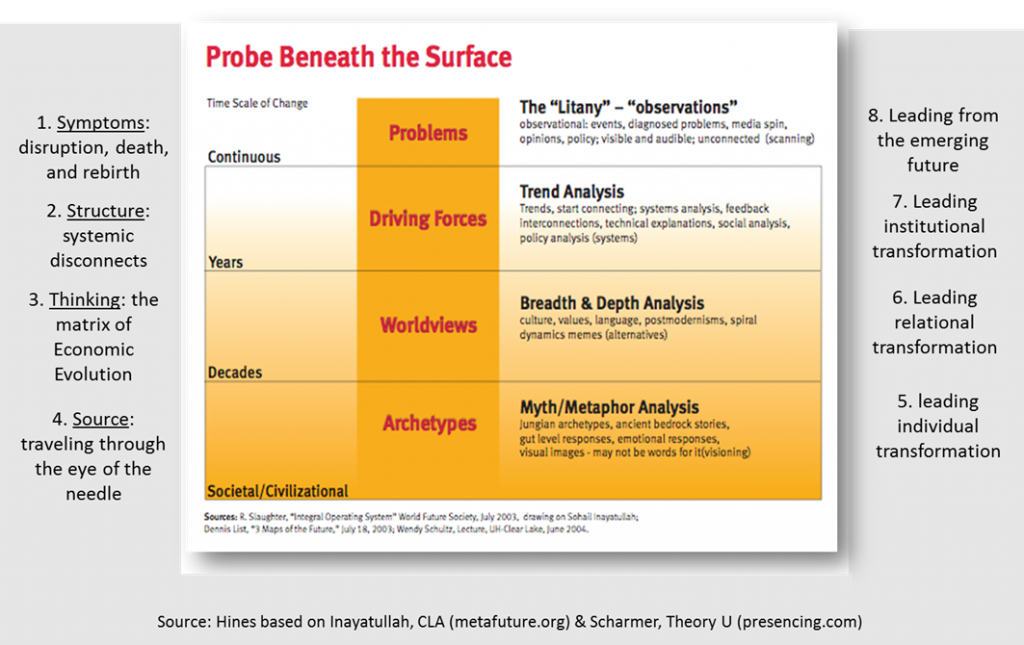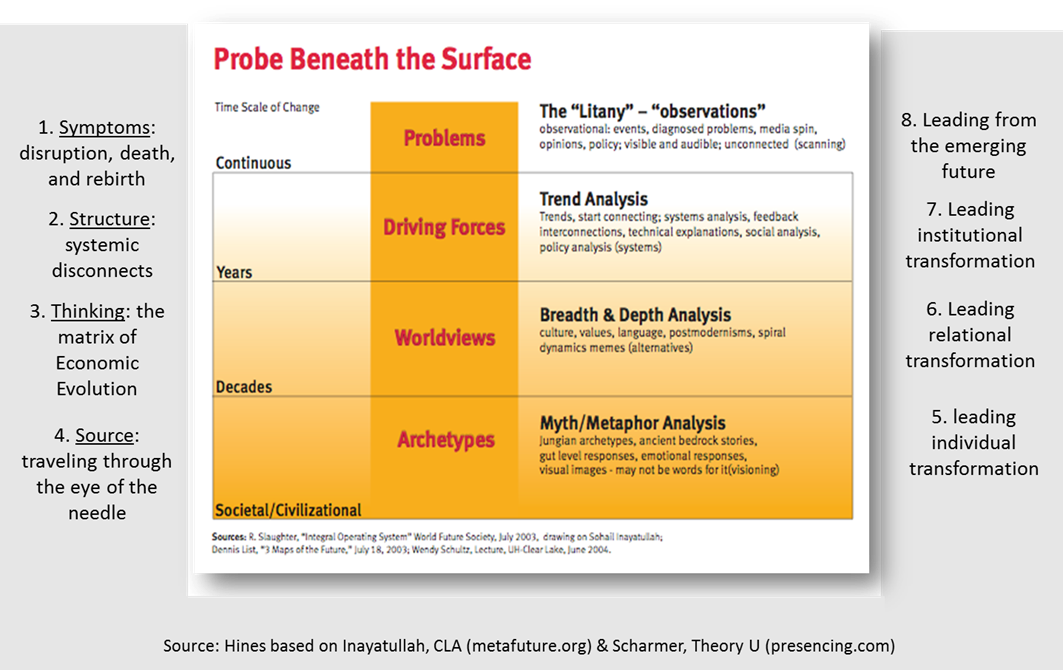I was reviewing Otto Scharmer’s “Leading from the Emerging Future” this weekend, prepping for Alternative Perspectives class in the fall, and it struck me how the “U” and the “iceberg” of CLA seemed to be quite similar. I did a quick-and-dirty search to see if anyone had noted this, but did not find anything. I have been intrigued by Scharmer’s ideas on Presencing and Theory U, and have shared them in class, but I really haven’t figured out the application. The theory makes conceptual sense, but I haven’t used it in practice. With our program’s emphasis on application, this has left me a bit uncomfortable. Which is long way of saying, I’m searching for a way to integrate the ideas into my tool kit (and thus my teaching kit).
So, in Leading from the Emerging Future, Scharmer devotes a chapter to the various activities of the “U:”
The first fo
ur chapters invite you to travel down the left side of the U:
- symptoms: disruption, death, and rebirth
- structure: systemic disconnects
- thinking: the Matrix of Economic Evolution
- source: traveling through the eye of the needle
The next four chapters take you up the right side of the U:
- leading individual transformation
- leadingrelational transformation
- leading institutional transformation
- leading from the emerging future

Scharmer even uses iceberg metaphor that is commonly used to explain CLA. I’m also familiar with using CLA in a down-and-up or up-and-down brainstorming exercise. The combination hear suggests beginning with the surface level manifestations of what we’re exploring and progressively going deeper. I like Scharmer’s “system disconnects” as I often explain the second level of CLA as “trends and systems.” I think the third level is a bit different and I think worldview is more helpful. As the bottom, we get to the deepest level of analysis on the left, and then begin the journey back up. It’ interesting that Scharmer starts with the individual. It’s a notion that we’ve heard from Richard Slaughter in his recent “Biggest Wake Up Call,” that is, starting with individual mindsets, and working from there. When we get to the top, we have “presenced” the emerging future, if you will.
It also strikes my that Sohail’s original article called CLA deconstructing (left-side of U) and reconstructing (right side of U). Some weekend speculations to share. I’d love to hear some reactions, as I’m just floating some ideas out there at this point. Andy Hines

There seem to be some interesting parallels between these theories . . . The question that strikes me is how to get the individuals who most need to be involved into the process. Right now, I’m involved in a discussion on another board about the current Israel-Hamas conflict, with Israelis and Palestinians caught in the crossfire. I believe that CLA/Theory U might be a great way of getting both sides to see the reality the other is living in — but you’d have to get the heads of both organizations into the process if you really wanted to succeed in resolving the conflict.
How do you do that? Is it possible that anyone can? Or are these processes only applicable to organizations that want to change — as opposed to organizations that can only conceive of victory?
Suggestive observations, Andy.
Don’t let your discomfort with TU discourage you. I acquired extensive formal TU training in 2010 and still can’t get my head around some of the more fuzzy aspects of TU.
Both CLA and TU adhere to Ken Wilber’s Integral Theory and the layered structure herein. And I think it is safe to say, that both frameworks owe a lot to systems thinking and the learning theory of Gregory Bateson.
Although he never refers to Bateson, Scharmer seems to thread where Bateson paused in his postulation of levels of learning. Beyond the Level Two learning, the capacity to reflect on mental models, Bateson postulated a Level Three without going into detail, and stating that it hardly ever happened and if, only through mystical experience or personal therapy. Scharmer names it Presencing, and the language surrounding this state is strikingly mystical, using imagery like “through the eye of the needle” and “breaking through a membrane”. All very inciting but not very helpful.
Scharmer refers to TU as a “social grammar” and it is not really a theory in any scientific application of the word. In his earlier books, he presents TU as a framework for engaging people in change processes or “social innovation”, but in “Leading from the Emerging Future” he uses it much more analytical to make a state-of-the-world diagnosis and then to call for action. I think this application makes the similarities between TU and CLA all the more apparent.
As to the practical application of TU, there are a few descriptions in Scharmers earlier book “Theory U” (2009), but a much more direct combination of TU and scenario planning can be found in Adam Kahane’s book, “Transformative Scenario Planning” (2012) – among others concerning the future of South Africa after apartheid.
I personally find CLA more suitable as an isolated analytical tool, but the TU process-levels are excellent to lead a diverse group of people through more ambitious scenario thinking.
Best regards
Niels
excellent, very helpful Niels! I have gone through most of the Presencing/Theory U stuff. It’s intriguing and makes sense to me — perhaps I’m looking for the right opportunity to work with it in practice? I dunno…..I’ll put Adam’s book on my list.